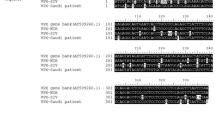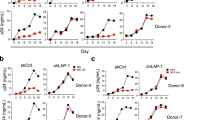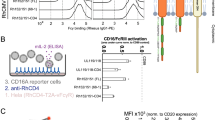Abstract
Human cytomegalovirus (HCMV) is a ubiquitous herpesvirus that causes life-threatening disease in patients who are immunosuppressed for bone marrow or tissue transplantation or who have AIDS (ref. 1). HCMV establishes lifelong latent infections and, after periodic reactivation from latency, uses a panel of immune evasion proteins to survive and replicate in the face of robust, fully primed host immunity2,3. Monocyte/macrophages are important host cells for HCMV, serving as a latent reservoir and as a means of dissemination throughout the body4. Macrophages and other HCMV-permissive cells, such as endothelial and glial cells, can express MHC class II proteins and present antigens to CD4+ T lymphocytes. Here, we show that the HCMV protein US2 causes degradation of two essential proteins in the MHC class II antigen presentation pathway: HLA-DR-α and DM-α. This was unexpected, as US2 has been shown to cause degradation of MHC class I (refs. 5,6), which has only limited homology with class II proteins. Expression of US2 in cells reduced or abolished their ability to present antigen to CD4+ T lymphocytes. Thus, US2 may allow HCMV-infected macrophages to remain relatively 'invisible' to CD4+ T cells, a property that would be important after virus reactivation.
This is a preview of subscription content, access via your institution
Access options
Subscribe to this journal
Receive 12 print issues and online access
$209.00 per year
only $17.42 per issue
Buy this article
- Purchase on SpringerLink
- Instant access to full article PDF
Prices may be subject to local taxes which are calculated during checkout




Similar content being viewed by others
References
Soderberg-Naucler, C., Fish, K.N. & Nelson, J.A. in Persistent Viral Infections (eds. Ahmed, R. & Chen, I.) 209–242 (John Wiley & Sons, New York, 1998).
Johnson, D.C. & Hill, A.B. Herpesvirus evasion of the immune system. Curr. Top. Microbiol. Immunol. 232, 149–177 (1998).
Ploegh, H.L. Viral strategies of immune evasion. Science 280, 248–253 (1998).
Soderberg-Naucler, C., Fish, K.N. & Nelson J.A. Reactivation of latent human cytomegalovirus by allogeneic stimulation of blood cells from healthy donors. Cell 91 119–126 (1997).
Wiertz, E.J. et al. Sec61-mediated transfer of a membrane protein from the endoplasmic reticulum to the proteasome for destruction. Nature 384, 432–438 (1996).
Jones, T.J. & Sun, L. Human cytomegalovirus US2 destabilizes major histocompatibility complex class I heavy chains. J. Virol. 71, 2970–2979 ( 1997).
York, I.A. & Rock, K.L. Antigen processing and presentation by the class I major histocompatibility complex. Annu. Rev. Immunol. 14, 369–396 ( 1996).
Nordeng, T.W., Gorvel, J.-P. & Bakke, O. Intracellular transport of molecules engaged in the presentation of exogenous antigens. Curr. Top. Microbiol. Immunol. 232, 179–215 ( 1998).
Cresswell, P. & Howard, J. Antigen recognition. Curr. Opin. Immunol. 11, 61–63 (1999).
Fish, K.N., Soderberg-Naucler, C. & Nelson, J.A. Steady-state plasma membrane expression of human cytomegalovirus gB is determined by the phosphorylation state of Ser900. J. Virol. 72, 6657–6664 ( 1998).
Basta, P.V., Sherman, P.A. & Ting, J.P. Identification of an interferon-gamma response region 5' of the human histocompatibility leukocyte antigen DR alpha chain gene which is active in human glioblastoma multiforme lines. J. Immunol. 138, 1275–1280 (1987).
Jones, T.R. et al. Multiple independent loci within the human cytomegalovirus unique short region down-regulate expression of major histocompatibility complex class I heavy chains. J. Virol. 69, 4830 –4841 (1995).
Steimle, V., Siegrist, C.A., Mottet, A., Lisowska-Grospierre, B. & Mach, B. Regulation of MHC class II expression by interferon-gamma mediated by the transactivator gene CIITA. Science 265, 106– 109 (1994).
Miller, D.M. et al. Human cytomegalovirus inhibits major histocompatibility complex class II expression by disruption of the Jak/Stat pathway. J. Exp. Med. 187, 675–683 ( 1998).
Gossen, M. & Bujard, H. Tight control of gene expression in mammalian cells by tetracycline-responsive promoters. Proc. Natl. Acad. Sci. USA 89, 5547–5551 (1992).
Dusseljee, S. et al. Removal and degradation of the free MHC class II beta chain in the endoplasmic reticulum requires proteasomes and is accelerated by BFA. J. Cell Sci. 111, 2217– 2226 (1998).
Fenteany, G. et al. Inhibition of proteasome activities and subunit-specific amino-terminal threonine modification by lactacystin. Science 268, 726–731 (1995).
Bogyo, M. et al. Covalent modification of the active site threonine of proteasomal beta subunits and the Escherichia coli homolog HslV by a new class of inhibitors. Pro. Natl. Acad. Sci. USA 94, 6629–6634 (1997).
Yang, M., Omura, S., Bonifacino, J.S. & Weissman, A.M. Novel aspects of degradation of T cell receptor subunits from the endoplasmic reticulum (ER) in T cells: importance of oligosaccharide processing, ubiquitination, and proteasome-dependent removal from ER membranes. J. Exp. Med. 187, 835–846 ( 1998).
Denzin, L.K. & Cresswell, P. HLA-DM induces CLIP dissociation from MHC class II alpha beta dimers and facilitates peptide loading. Cell 82, 155–165 ( 1995).
Schust, D.J., Tortorella, D., Seebach, J., Phan, C. & Ploegh, H.L. Trophoblast class I major histocompatibility complex (MHC) products are resistant to rapid degradation imposed by the human cytomegalovirus (HCMV) gene products US2 and US11. J. Exp. Med. 188, 497–503 ( 1998).
Mosyak, L., Zaller, D.M. & Wiley, D.C. The structure of HLA-DM, the peptide exchange catalyst that loads antigen onto class II MHC molecules during antigen presentation. Immunity 9, 377–383 (1998).
Schoenberger, S.P., Toes, R.E., van der Voort, E.I., Offringa, R. & Melief, C.J. T-cell help for cytotoxic T lymphocytes is mediated by CD40-CD40L interactions. Nature 393, 480–483 (1998).
Chang, C.H., Fontes, J.D., Peterlin, M. & Flavell, R.A. Class II transactivator (CIITA) is sufficient for the inducible expression of major histocompatibility complex class II genes. J. Exp. Med. 180, 1367–1374 ( 1994).
Ligas, M.W. & Johnson, D.C. A herpes simplex virus mutant in which glycoprotein D sequences are replaced by β-galactosidase sequences binds to but is unable to penetrate into cells. J. Virol. 62, 1486–1494 (1988).
Hardy, S., Kitamura, M., Harris-Stansil, T., Dai, Y. & Phipps, M.L. Construction of adenovirus vectors through cre-lox recombination. J. Virol. 71, 1842–1849 (1997).
York, I.A. et al. A cytosolic herpes simplex virus protein inhibits antigen presentation to CD8+ T lymphocytes. Cell 77, 525–535 (1994).
Needleman, S.B. & Wunsch, C.D. A general method applicable to the search for similarities in the amino acid sequence of two proteins. J. Mol. Biol. 48, 443– 453 (1970).
Acknowledgements
We thank B. Walters, J. DeKoning, K. Fish and C. Soderberg-Naucler for supplying preliminary data and advice in the early stages of this work and M. Bogyo, D. Kavanagh and J. Trowsdale for reagents and antibodies. The work was supported by NIH grants EY11245 to D.C.J., AI24178 to J.A.N. and AI41754 to S.R.R. and AI01644 to D.M.L.
Author information
Authors and Affiliations
Corresponding author
Rights and permissions
About this article
Cite this article
Tomazin, R., Boname, J., Hegde, N. et al. Cytomegalovirus US2 destroys two components of the MHC class II pathway, preventing recognition by CD4+ T cells. Nat Med 5, 1039–1043 (1999). https://doi.org/10.1038/12478
Received:
Accepted:
Issue Date:
DOI: https://doi.org/10.1038/12478
This article is cited by
-
KSHV infection of B cells primes protective T cell responses in humanized mice
Nature Communications (2024)
-
The non-classical major histocompatibility complex II protein SLA-DM is crucial for African swine fever virus replication
Scientific Reports (2023)
-
Modulation of innate and adaptive immunity by cytomegaloviruses
Nature Reviews Immunology (2020)
-
Human cytomegalovirus evades antibody-mediated immunity through endoplasmic reticulum-associated degradation of the FcRn receptor
Nature Communications (2019)
-
Challenges and Clinical Implications of the Diagnosis of Cytomegalovirus Lung Infection in Children
Current Infectious Disease Reports (2019)



